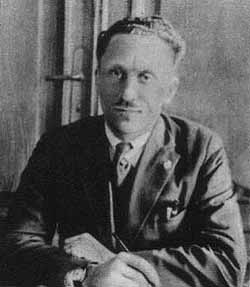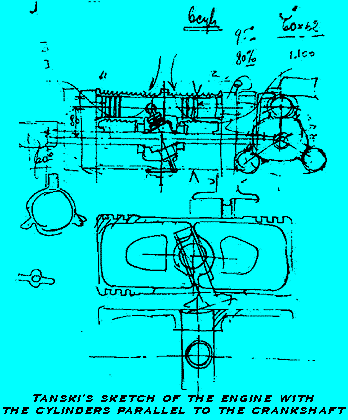


Tadeusz Tanski (1892 - 1941) - son of a well-known painter and aviation promoter, Czeslaw Tanski - was educated at the Paris Electrical College where he graduated in 1916. In 1916-1918, as a freelance engineer, he constructed powerplants, vehicles and air-compressors for various companies in France. His most significant achievements in that time were: a big 12-cylinder (ca. 500 HP) flat aero-engine with the cylinders arranged in the shape of rotated letter H, and a four-cylinder, two-stroke radial engine for the light aircraft.
 In 1919, soon after Poland regained its independence, Tanski left France and upon his return to Poland was offered a job in the newly-formed Centralne Warsztaty Samochodowe - CWS (Central Automobile Works). When Poland became involved in a (victorious) military conflict with the Soviet Union (1919-1920), Tanski was comissioned to design a light armoured vehicle based on the chassis of the Ford T (Fords, being widely used by the Polish Army, were actually assembled by CWS). The vehicle was ready in 1920. It was operated by a crew of two: the driver in a reclined position and the machine-gunner sitting behind him. The first six vehicles were sent to the front line for the final tests and Tanski went along with them, unprotected in an open civilian Ford, to see how his construction worked. Although he returned safe and sound, a serious argument with the CWS' management was inevitable...
In 1919, soon after Poland regained its independence, Tanski left France and upon his return to Poland was offered a job in the newly-formed Centralne Warsztaty Samochodowe - CWS (Central Automobile Works). When Poland became involved in a (victorious) military conflict with the Soviet Union (1919-1920), Tanski was comissioned to design a light armoured vehicle based on the chassis of the Ford T (Fords, being widely used by the Polish Army, were actually assembled by CWS). The vehicle was ready in 1920. It was operated by a crew of two: the driver in a reclined position and the machine-gunner sitting behind him. The first six vehicles were sent to the front line for the final tests and Tanski went along with them, unprotected in an open civilian Ford, to see how his construction worked. Although he returned safe and sound, a serious argument with the CWS' management was inevitable...
In Warsaw, Tadeusz Tanski was a regular in a cafe on Senatorska Street where he used to spend hours occasionally making drawings on paper napkins. He believed that beautiful constructions ought to be mechanically sound, so he used to draw the shape of a machine first and position all the necessary internal mechanisms afterwards. The hand-drawings of the CWS T-1 car were thus first made in the early Twenties. The elevations in his technical drafts were all superimposed one upon another to avoid tedious dimensioning, but they had to be interpreted and re-drawn before submission to the workshops.
 Tanski's individualism hardly helped him in his professional career. As he ignored all schedules and deadlines, designing the gearbox for the CWS T-1 prototype was significantly delayed. A desperated Kazimierz Meyer, the CWS director, decided to lock up his unruly constructor in a study for a night but the following morning he found Tanski bent over a pile of designs of ... women scarves! Tanski apologised to his boss and sat at his drawing-board again. In a few hours the gearbox was ready; and apparently not a bad one! It was modern and simple, with an incorporated patented lock which secured the car against unauthorized usage. Since simplicity of his constructions was also one of Tanski's aims, the CWS automobiles had one unparalleled feature: all the screws were of the same (M10) size! (Except standardized sparking plugs, which had the M18 thread.) Owing to this, a CWS car could be taken into pieces with only one wrench.
Tanski's individualism hardly helped him in his professional career. As he ignored all schedules and deadlines, designing the gearbox for the CWS T-1 prototype was significantly delayed. A desperated Kazimierz Meyer, the CWS director, decided to lock up his unruly constructor in a study for a night but the following morning he found Tanski bent over a pile of designs of ... women scarves! Tanski apologised to his boss and sat at his drawing-board again. In a few hours the gearbox was ready; and apparently not a bad one! It was modern and simple, with an incorporated patented lock which secured the car against unauthorized usage. Since simplicity of his constructions was also one of Tanski's aims, the CWS automobiles had one unparalleled feature: all the screws were of the same (M10) size! (Except standardized sparking plugs, which had the M18 thread.) Owing to this, a CWS car could be taken into pieces with only one wrench.
It often happened that Tanski was short of money and his friends weren't too keen on lending him any. In such straits, Tanski looked around for a construction contest to enter with his designs and... often winning a prize. The most famous story is related to a two-cylinder air-cooled 750 cc engine designed to compete for selection for an electricity generating powerplant. The prototype (named TO-1) had been completed just one day before the official reliability test (1000 hours of non-stop operation) began. It successfully completed the test, proving the engine's superiority above the other competitors which included famous motorcycle manufacturers. When a nice sum of prize money landed in his pocket, Tanski could resume visiting his favourite cafe to think up his dream machines. Some of his designs were truly exceptional like, for instance, the engine with cylinders parallel to the crankshaft (original hand-drawing reproduced here) or the 100 HP, five-cylinder radial aero-engine (also designed for a contest). In the latter case, the entire powerplant body consisted of two halves of pressed steel. The halves were welded together, the cylinders re-bored and the aluminium ribbing wedged onto each cylinder. The nearly completed engine, with pistons and rods fitted, was then slid onto the crankshaft and secured with one central nut.
Tanski's activities weren't limited to cars or engines. With equal ease he was able to construct a marine torpedo or an automatic photo enlarger. But Tanski, with his fantastic ideas and a notorious lack of time, was a difficult co-worker. With the personal relations at PZInz becoming more formal, Tanski became involved in innumerable conflicts with the management. Consequently, he was offered increasingly less attractive posts in the company as the years passed by.
Tadeusz Tanski died in the German-Nazi concentration camp, Auschwitz, in 1941.